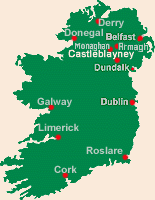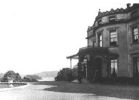|
www.proni.gov.uk/records/private/blayney.htm Briefly, Edward, the first of the Blayneys in Ireland and the founder of the town, became Baron Blayney of Monaghan on 29 July 1621. His son Lord Henry took a seat in the Irish House of Lords in 1634. His castle was attacked by the Irish "rebels" under MacMahon in 1641, from which he escaped to warn Dublin (although his wife and children were captured) and he was later killed at the battle of Benburb in 1646.
The 3rd Lord Blayney, Edward3 sold both the family's estates in Monaghan and Castleblayney to a London merchant Thomas Vincent, but Edward's brother, Richard, married Thomas Vincent's daughter in 1653 bringing the CastleBlayeny estates back to the Blayney family. Monaghan, however, went to the Westenras, who later became the Lords Rossmore, less well tolerated by the native Irish - [ref]. Richard's son Henry Vincent (the 5th Lord Blayney) was chosen as commander-in-chief of the Protestant forces raised to defend Monaghan and Armagh against King James II, but he died in 1689 (the year before James II's defeat at the Battle of the Boyne). Prior to the early 1700s, the village of Castleblayney was on the east side of Lough Muckno but after then Lord Blayney's residence and the whole town moved to the west side of the lake to take advantage of the Dublin to Derry traffic. [78]
The Hope Castle (previously known as Blayney Castle) "is one of the last remaining symbols of British rule in Monaghan. Beautiful and historical..." [ref]. Unfortunately at 8.21 pm on Sunday 7th March 1976 a car bomb exploded in the centre of the main street of Castleblayney killing one man Patrick Mone (56) [354], injuring seventeen (or 29 [363]) others and causing widespread damage in the Main Street of the town. This event brought Castleblayney into the full contact with the Northern Troubles. It came as a great shock to the local people that Castleblayney should have been targeted for such an atrocity. But no explanation was ever given, other than the rather unhelpful Barron Report (Independent Commission of Inquiry) on 5 July 2006 which stated that �Under the circumstances, the only conclusion one can come to is that someone from Northern Ireland was responsible for this outrage.� [363] No one was ever arrested for this bombing. Other than times when sectarian and religious violence polarised the loyalist and Protestant Blayney Lords and the largely Catholic and Republican local population, the relationship between the local population and the Blayney landowners tended to be co-operative and supportive, unlike many other landowners. The latter Lords built both Protestant and Catholic churches as well as supporting schools and an almshouse for the poor.
| ||||||||||
Further off-site pictures:
| ||||||||||
| Keith Blayney Homepage | Gregynog | Blayney Barons | Blayney History |






